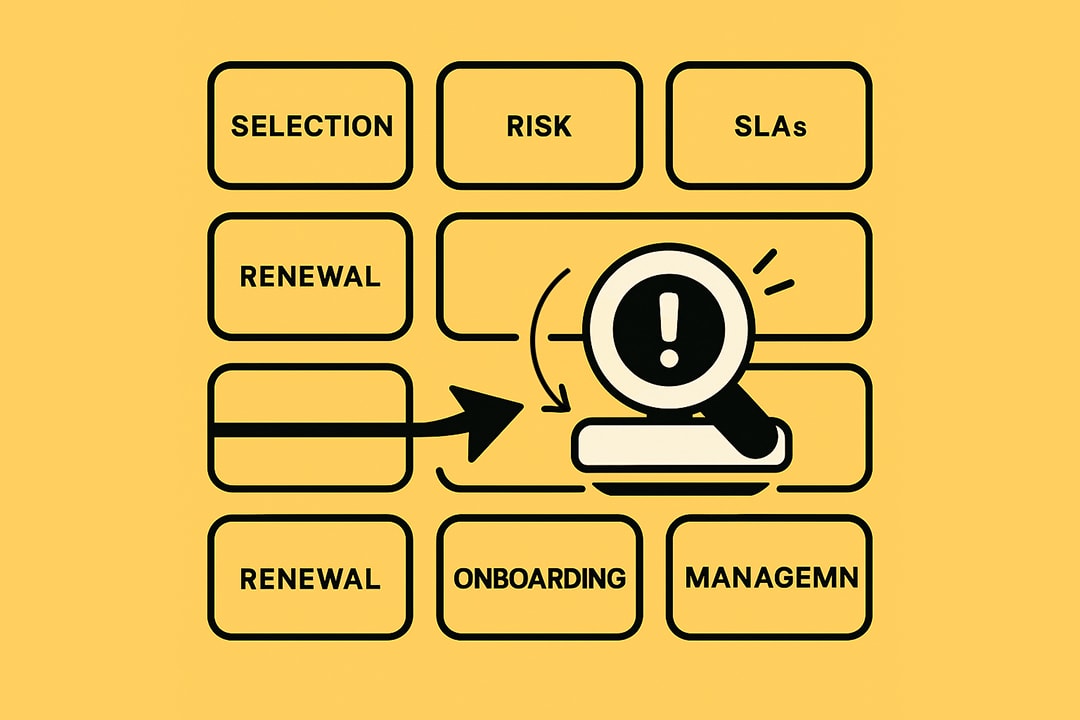Vendor management—Best practices and mistakes to avoid
Discover best practices and common pitfalls in vendor management. Learn how a strong vendor management process and metrics drive better IT outcomes.

Managing vendors without auditable, structured processes add unnecessary opacity to your vendor management process. Not having everything on a dashboard comes back to bite you in ways like the CFO questioning why the IT spend is up.
And when you dig into it further you realize one of the contracts auto-renewed last month at a 22% increase, another vendor's compliance report expired months ago, while another has been slacking on their SLAs for the past quarter.
This isn't failure but negligence and it happens to the best of us. The difference between structure and chaos isn't more work but right work. If only you can create a repeatable, defendable system.
This guide breaks down not just how vendor management works but also what are some of the best practices you can incorporate to stand out and make changes fast.
Why vendor management feels impossible (and why it doesn't have to be)
Vendor management in a modern IT environment isn't hard because IT leaders lack competence it's hard because there is a general lack of structure or importance amidst the hundreds of things you need to take care of.
You're managing 60, 80, sometimes 100+ vendors across cloud, security, SaaS, infrastructure, and support. Each one came in through a different door: a business unit bypassed procurement, a legacy contract auto-renewed without review, an urgent security gap forced a 72-hour decision.
There's no central record of what you have, what it costs, or who owns it. Contracts live in email threads. Compliance docs expire quietly. Performance is tracked in someone's head, if at all.
And when something breaks—a vendor breach, a surprise price hike, a compliance audit that surfaces gaps—you're the one holding the bag.
It costs you credibitlity
When vendor management is ad-hoc, every failure looks like your failure. A vendor's security incident becomes your incident. Shelf ware shows up in budget reviews as wasteful spending on your watch. The C-suite doesn't see the absence of a system, they see the absence of control.
And here's the part no one says out loud: you can't fix this by working harder. You can't spreadsheet your way out of vendor sprawl. You can't manually track compliance across dozens of suppliers while also delivering on transformation projects, managing your team, and keeping the lights on.
What changes everything: shifting from chaos to system
Vendor management stops feeling impossible the moment it stops being a hundred one-off tasks and becomes a repeatable system. Not a perfect system. Not a system that requires a dedicated team or a six-figure platform. Just a system—a vendor management lifecycle that defines how vendors enter, how they're monitored, how they're measured, and how they exit.
When intake is standardized, vendor selection isn't a negotiation every time, it's a playbook. When due diligence is tiered, you're not drowning in questionnaires for low-risk tools. When renewals are tracked and triggered automatically, you're not caught flat-footed before a contract locks in. When performance data is centralized, you walk into every vendor conversation with leverage, not hope.
The system doesn't eliminate the complexity. It makes the complexity manageable. It turns vendor management from a liability into a capability that reduces risk, controls cost, and makes every decision defensible.
Reducing risk continuously, not once
A vendor management lifecycle means risk is never a checkbox. It’s a continuous loop of assessment, monitoring, and action. Miss a vulnerability or a change in a vendor’s financial posture, and suddenly “business as usual” becomes an incident report. Security, compliance, and business continuity all rest on the discipline of an ongoing vendor management process. With proper vendor selection in IT, risk assessment isn’t just at onboarding—it’s proactive and repeatable.
Controlling cost and complexity
Without a standardized vendor management process, tool sprawl and shelf ware are inevitable. Procurement and IT leaders have all seen the spreadsheet graveyard: duplicate vendors, unused licenses, and overlapping contracts. A robust vendor management lifecycle forces a ruthless focus on what’s needed, what’s working, and what gets cut. Vendor selection in IT is about more than picking a name from a list; it’s about ensuring every dollar spent has a business case and every renewal is justified by outcomes.
Enabling speed and defensibility
When vendor management is ad-hoc, decision cycles slow to a crawl. Approvals bounce between teams, requirements shift midstream, and nothing is traceable. A disciplined vendor management lifecycle means everyone knows the playbook: intake, evaluation, due diligence, onboarding, performance, renewal, and offboarding. This clarity cuts wasted time and makes decisions defensible to auditors, boards, and the C-suite.
Increasing leverage at renewal
Renewals are where value is won or lost. If you aren’t tracking performance, usage, and risk, you have no leverage when renegotiating terms or challenging price hikes. The vendor management process keeps all the cards on the table—usage data, KPI trends, SLA adherence, risk findings—so every renewal starts from a position of strength. Structured vendor selection in IT, paired with lifecycle data, ensures negotiations are fact-based and outcomes driven.
Scaling with confidence
Growth means more vendors, more complexity, and more scrutiny. Manual tracking or tribal knowledge can’t scale. The vendor management lifecycle delivers a system that grows with the business, supports more categories and regions, and stands up to internal and external audits. It gives IT leaders and procurement teams the confidence to say “yes” to new needs, knowing the foundation is solid.
Best practices you should implement for better vendor management
Best practices in vendor management aren’t theoretical, they’re what separate efficient, audit-ready operations from chaos. The right vendor management process is structured, proactive, and built to scale. Below are specific, actionable best practices for every IT leader managing a modern vendor portfolio.
Centralize vendor data and workflows
Centralize all vendor information—contracts, compliance docs, KPIs, and communications—in a dedicated vendor management platform. This single source of truth anchors every stage of the vendor management lifecycle. Don’t rely on scattered spreadsheets or siloed inboxes.
A unified system minimizes risk, accelerates the vendor management process, and ensures that every stakeholder, from security to finance, works from the same data. In vendor selection, having real-time access to historical performance and risk data informs smarter decisions.
Standardize processes for every stage
Vendor management depends on repeatable, enforceable steps. Implement playbooks and checklists for each phase: intake, vendor selection, due diligence, contracting, onboarding, performance reviews, and offboarding. These tools make the vendor management lifecycle predictable and auditable. Use a structured vendor selection process to ensure all vendors are evaluated on consistent, weighted criteria—never on gut feel or whoever talks the loudest.
Conduct thorough, tiered due diligence
Due diligence is not just a hurdle at onboarding; it’s an ongoing safeguard. Segment vendors by risk and criticality, and scale the depth of your assessments accordingly. For every vendor selection in IT, validate security (SOC 2, ISO 27001), privacy (DPA, data flows), and financial stability.
Automate reminders for periodic reassessment and ensure evidence is always up to date. Integrate evidence reuse; don’t ask for the same audit reports twice. This approach embeds risk control throughout the vendor management process.
Set measurable KPIs and SLAs
Clear, quantifiable KPIs are the backbone of effective vendor management. Define reliability (uptime, MTTR), adoption (active usage, feature utilization), outcome KPIs, and compliance targets up front—then put them in every contract. Use scorecards and dashboards to visualize performance across the vendor management lifecycle. This turns vendor selection and renewals into data-driven decisions, not best guesses.
Automate alerts and renewals
Automation is critical in a mature vendor management process. Configure system alerts for contract expirations, compliance deadlines, renewal windows, and performance reviews. This prevents missed renewals, lapsed certifications, and last-minute fire drills. Automated workflows ensure the vendor management lifecycle keeps moving, even when teams are busy or roles change.
Segment and prioritize vendors
Not all vendors are created equal. Use risk-based segmentation to apply the right level of scrutiny to each supplier. Focus the most effort on high-risk and mission-critical vendors, while still maintaining oversight on others. This keeps the vendor management process efficient and ensures that vendor selection in IT is focused where it matters most.
Foster collaboration and communication
Vendor management isn’t just transactional. Build a relationship with your suppliers through regular check-ins, QBRs, and feedback loops. Encourage joint problem-solving and transparency when issues arise. Document everything—decisions, escalations, corrective actions—so nothing gets lost and blame games are avoided. A collaborative approach throughout the vendor management lifecycle turns vendors into long-term partners, not just line items.
Document everything
Every decision, exception, and corrective action needs to be logged. This creates an auditable trail and supports continuous improvement. Store documentation in your vendor management platform, not in personal email or private drives. Comprehensive documentation strengthens every phase—from vendor selection to offboarding—and is essential for compliance, dispute resolution, and executive reporting.
Common pitfalls and how to avoid them
Even with a strong vendor management process, certain traps can undermine the entire vendor management lifecycle. Recognizing and proactively addressing these pitfalls is essential for robust vendor management and effective vendor selection in IT.
Lack of standardized processes
Inconsistent onboarding, evaluation, or offboarding creates gaps and confusion. Without a standardized vendor management process, critical details slip through the cracks, compliance falters, and audit trails are incomplete. The fix: enforce lifecycle playbooks and checklists at every stage. Make the vendor selection process, due diligence, and performance reviews non-negotiable steps, not suggestions.
Ignoring renewals and expirations
Autorenewals and missed contract notice periods can lock your organization into costly, outdated agreements. Failing to track renewal milestones is a recurring weakness in vendor management. Address this by capturing machine-readable contract terms and automating “notify/no auto renew” workflows. Use a 90/60/30 review cadence to ensure every renewal is scrutinized with the same rigor as initial vendor selection in IT.
Over-reliance on single vendors
Relying too heavily on one vendor exposes the organization to disruption if that partner fails. This concentration risk is often overlooked during vendor selection and throughout the vendor management lifecycle. Mitigate it by diversifying suppliers whenever possible, and always establishing transition plans and clear exit criteria within the vendor management process.
Insufficient risk monitoring
Point-in-time assessments are not enough. Regulatory changes, financial instability, and new security threats can emerge at any time. A reactive approach to risk is a major pitfall in vendor management. Make risk monitoring continuous: automate alerts, schedule reassessments, and use dashboards to track critical changes. This keeps risk management tightly integrated into every phase of the vendor management lifecycle.
Poor communication
Missed updates, unclear escalation paths, and inconsistent feedback erode trust and efficiency. Vendor management depends on clear, regular communication—especially as vendor selection in IT brings more parties to the table. Standardize QBRs, define owner responsibilities, and document all decisions and escalations. This maintains alignment and prevents misunderstandings.
Neglecting contract details
Vague or incomplete contracts lead to disputes over performance, pricing, and responsibilities. This is a recurring failure in the vendor management process. Use clause libraries, obligation tracking, and regular reviews of contract terms. Ensure SLAs, data handling, credits, and exit provisions are explicitly detailed and traceable across the vendor management lifecycle.
Manual tracking
Email threads and spreadsheets are not sustainable for modern vendor management. Manual tracking leads to lost documentation, errors, and missed deadlines. Adopt a vendor management platform to automate workflows, centralize evidence, and provide audit-ready records for every vendor selection and engagement.
Reactive instead of proactive management
Waiting to act until problems surface limits improvement and compounds risk. Proactive management means reviewing performance and risk regularly, not just when issues arise. Set KPI thresholds, monitor trends, and launch preventive actions before they become urgent. This ensures the vendor management lifecycle continually drives better outcomes.
Closing thoughts
A disciplined vendor management process is the backbone of any resilient and high-performing IT operation. It’s not just about onboarding a new tool or negotiating a contract, it’s about maintaining control, reducing risk, and sustaining value at every stage of the vendor management lifecycle.
When every intake, vendor selection, due diligence, contract, and renewal is data-driven and standardized, teams move faster, spend less, and weather surprises with confidence.
Consistent best practices—centralized data, standardized workflows, measurable KPIs, and continuous risk monitoring—turn vendor management into a competitive advantage. Avoiding common pitfalls like manual tracking, stale risk reviews, and missed renewals keeps the operation tight and defensible, especially as complexity and pressure increase.
Metrics and reporting are what make progress real. They provide the feedback loop to spot gaps, prioritize improvements, and demonstrate value to leadership. When the vendor management lifecycle runs on evidence instead of anecdote, IT leaders can make decisions that are both fast and right.
The payoff for getting vendor management right is tangible: less risk, more leverage, lower costs, and a portfolio that works for the business instead of against it. Treat the vendor management process as a strategic capability, and every vendor selection in IT becomes a lever for growth, never a liability.
Begin with better vendor selection and avoid heavy mistakes
With TechnologyMatch, vendor discovery and selection become streamlined and noise-free, setting up the stage for better vendor management. Get matched with the right vendors and surf through our catalog of pre-vetted vendors.
FAQ
What are the key components of a vendor management process?
Key components include centralized vendor data, standardized workflows, objective vendor selection in IT, due diligence, performance monitoring, risk assessment, contract management, and structured renewals or offboarding.
How does a vendor management lifecycle benefit IT organizations?
A vendor management lifecycle provides ongoing risk visibility, cost control, faster decision-making, stronger negotiation leverage, and easier compliance by making every vendor selection and renewal structured and auditable.
What best practices improve vendor management outcomes?
Best practices include centralizing data, automating alerts, using measurable KPIs, conducting continuous risk monitoring, segmenting vendors by risk, and fostering transparent collaboration across stakeholders.
What common mistakes should be avoided in vendor management?
Avoid inconsistent processes, missed contract renewals, over-reliance on single vendors, manual tracking, vague contracts, and reactive (not proactive) risk management.
How do you measure success in vendor management?
Measure success by tracking time-to-decision, percentage of vendors with current risk assessments, contract savings, performance against KPIs, audit results, and renewal outcomes across the vendor management lifecycle.





